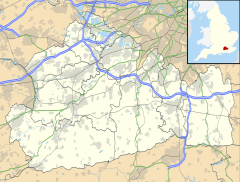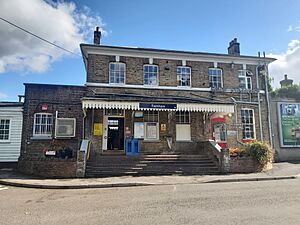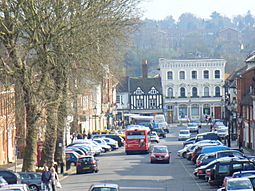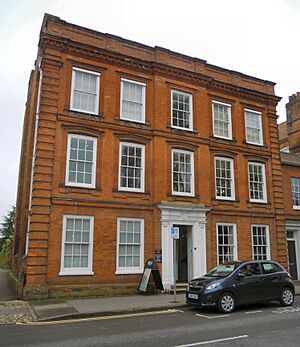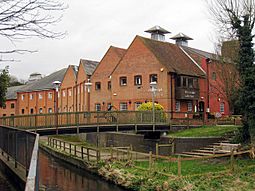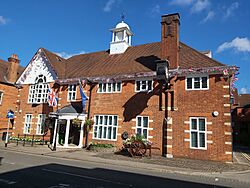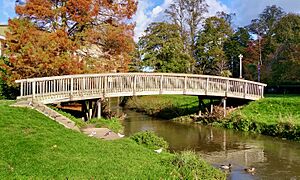Farnham facts for kids
Quick facts for kids Farnham |
|
|---|---|
| Market town and civil parish | |
 Castle Street |
|
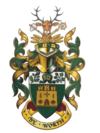 Coat of arms Motto: 'By Worth' |
|
| Area | 36.52 km2 (14.10 sq mi) |
| Population | 39,488 (civil parish) |
| • Density | 1,081/km2 (2,800/sq mi) |
| OS grid reference | SU8447 |
| Civil parish |
|
| District | |
| Shire county | |
| Region | |
| Country | England |
| Sovereign state | United Kingdom |
| Post town | Farnham |
| Postcode district | GU9 |
| Dialling code | 01525 |
| Police | Surrey |
| Fire | Surrey |
| Ambulance | South East Coast |
| EU Parliament | South East England |
| UK Parliament |
|
Farnham is a historic market town and civil parish located in Surrey, England. It sits about 36 miles southwest of London and is part of the Borough of Waverley. The town is close to the border with Hampshire and is built along the north branch of the River Wey, which flows into the River Thames. Farnham is also at the western end of the North Downs, a famous ridge of hills. The civil parish of Farnham includes nearby villages like Badshot Lea, Hale, and Wrecclesham. In 2011, its population was 39,488 people.
Farnham has a very long history. Scientists have found ancient objects here, including a woolly mammoth tusk in Badshot Lea. The first signs of human life date back to the Neolithic period (New Stone Age). During the Roman period, people made tiles near the town centre. The name "Farnham" comes from Anglo-Saxon words and likely means "meadow where ferns grow."
From the year 803, the powerful Bishops of Winchester controlled Farnham. The castle was built in 1138 by Bishop Henry de Blois as a place for the bishops to stay. Even Henry VIII lived at Farnham Castle when he was 16 years old!
In the Middle Ages, Farnham was known for making a coarse woollen cloth called kersey. Later, in the early modern period, its weekly corn market was one of the biggest in England. For centuries, Farnham was a major centre for growing hops (used in beer) and for the brewing industry. The town grew a lot in the Victorian era, especially after the railway opened in 1849 and the army arrived in nearby Aldershot in 1855. Farnham became an Urban District in 1894 and later a civil parish and town council in 1984.
Farnham is also famous for its creative arts and pottery. The University for the Creative Arts has a campus here. You can find many public artworks around town. Important historical places include the ruins of Waverley Abbey and the 18th-century Willmer House, which is now the Museum of Farnham. Many famous people were born or lived in Farnham, including politician William Cobbett, writer George Sturt, and Irish activist Maud Gonne. More recently, the town has been home to artist William Herbert Allen, Formula One driver Mike Hawthorn, cricketer Graham Thorpe, and rugby captain Jonny Wilkinson.
Contents
- What's in a Name? The History of "Farnham"
- Farnham's Natural Surroundings
- Farnham Through Time: A Brief History
- Getting Around Farnham
- Farnham's Economy and Shops
- Public Services and Fun Things to Do
- Visiting Farnham: Tourism
- Farnham's Culture and Arts
- Education in Farnham
- Sports and Activities
- Farnham's Population and Homes
- How Farnham is Governed
- Local News
- Parks and Green Spaces
- Famous People from Farnham
- See also
What's in a Name? The History of "Farnham"
The earliest record of Farnham is from around 1150, where it's called Fernham. In the Anglo-Saxon Chronicle from about 900, it's written as Fearnhamme. The name changed to Ferneham in the Domesday Book of 1086. The modern spelling "Farnham" first appeared in 1233.
The name likely comes from two Old English words: fearn (meaning fern) and ham (meaning homestead or enclosure). So, it probably means "homestead where ferns grow." Another idea is that hamm could mean "river meadow."
Farnham's Natural Surroundings
Farnham's location has always been important to its development. The mix of rivers, streams, fresh springs, and different soils, along with a mild climate, made it an attractive place for people to live even in prehistoric times. The local geology (the study of Earth's rocks and features) still affects the town today, from its roads to its beautiful scenery and local industries like farming and mining.
Farnham is in the valley of the North Branch of the River Wey. This river starts near Alton, joins another branch at Tilford, and then flows into the River Thames at Weybridge. The hills and valleys mostly run east to west, which has shaped how roads and railways were built.
The most noticeable geological feature is the chalk of the North Downs. This forms a ridge called the Hog's Back to the east of town. It also runs through Farnham Park to the north and extends west into the Hampshire Downs. North of town, the land rises to over 180 metres (590 feet) above sea level at Caesar's Camp. The historic centre of Farnham sits on gravel beds, about 70 metres (230 feet) above sea level.
Farnham's Climate
Farnham has a mild climate without extreme temperatures. It gets moderate rainfall and is often breezy. The closest weather station is Alice Holt Lodge, about 3.5 miles southwest of the town.
The highest temperature ever recorded was 35.4°C (95.7°F) in July 2006. On average, the warmest day of the year reaches about 26.3°C (79.3°F). The lowest temperature recorded was -14.0°C (6.8°F) in February 1986. On average, there are about 58 nights a year with frost. Farnham gets about 821mm (32.3 inches) of rain annually, with rain on about 126 days.
Farnham Through Time: A Brief History
Ancient Times: Stone, Bronze, and Iron Ages
Farnham's history goes back hundreds of thousands of years. Stone tools found around the town show that hunter-gatherers lived here in the early Stone Age. A woolly mammoth tusk was even found in Badshot Lea!
The first known settlement was about 7,000 years ago in the Mesolithic period. People lived in pit dwellings and made flint tools. A large ancient burial mound called a long barrow was once in Badshot Lea, but it's now gone due to quarrying. An old prehistoric trackway called the Harrow Way passes through Farnham Park. A large stone called a sarsen still stands nearby, thought to mark a safe crossing point over a marshy area.
Life continued to grow in the Bronze Age. Two hoards of bronze objects were found on Crooksbury Hill. Many Bronze Age burial mounds, called barrows, are in the area, including a triple barrow at Elstead.
In the early Iron Age, people built Hill forts at Botany Hill and Caesar's Camp. Caesar's Camp is a very large earthwork on a high point, with a spring nearby. Later in the Iron Age, "Soldier's Ring" earthworks were built on Crooksbury Hill. By the 1st century AD, Farnham was part of the Belgic tribe called the Atrebates.
Roman Farnham: A Pottery Hub
During the Roman period, Farnham became a centre for making pottery. This was because there was plenty of gault clay, oak trees for fuel, and good roads like the Harrow Way. Kilns (ovens for firing pottery) from about AD 100 have been found. The main pottery centre was in Alice Holt Forest, which started around AD 50. These potteries made mostly everyday items until about AD 400.
Near the Bourne Spring, two Roman buildings were found: a bath-house from about AD 270 and a later house. The Roman Way housing estate is now on this site.
Anglo-Saxon Times: The Town's Name and Early Battles
In the 7th century, King Caedwalla of Wessex took control of Surrey. He founded a monastery in Farnham in 686. The Anglo-Saxons gave the town its name, "Farnham." It's listed as Fearnhamme in the Anglo-Saxon Chronicle.
By 803, Farnham belonged to the Bishop of Winchester. The Manor of Farnham stayed with the Bishops for nearly a thousand years. Although Farnham is mentioned in Saxon writings, only one Saxon site has been fully found. It's off Firgrove Hill, where Saxon weaving huts from about AD 550 were discovered in 1924.
In 892, a big battle happened in Surrey. A large Danish army raided Hampshire and Berkshire. As they left with their loot, they were stopped and defeated at Farnham by an army led by Alfred the Great's son, Edward the Elder. The Danes then fled across the Thames.
The Hundred of Farnham
A "hundred" was an old way of dividing land. It was an area where a main lord had power over smaller lords. In the 14th century, the Bishop of Winchester owned Farnham hundred, and it was one of the richest areas under the bishop's control.
After the Norman Conquest: Castle and Abbey
Farnham is mentioned in the Domesday Book of 1086 as Ferneham. It was one of the five main churches in Surrey.
Waverley Abbey, the first Cistercian abbey in England, was founded in 1128 by William Giffard, also a Bishop of Winchester. It's about 1 mile south of the town centre. Kings like King John and Henry III visited Waverley. The abbey created the famous Annals of Waverley, an important historical record. By 1536, when Henry VIII closed the monasteries, only thirteen monks lived there.

Farnham is located halfway between Winchester and London. In 1138, Henry de Blois began building Farnham Castle. This castle provided a place for the Bishop of Winchester to stay when travelling. The castle's soldiers created a market for local farms and businesses, helping the town grow.
Farnham officially became a town in 1249, thanks to William de Ralegh, who was then the Bishop of Winchester. The "Blind Bishop's Steps," which lead up to the castle, were built for Bishop Richard Foxe, who was Henry VIII's godfather.
The Black Death arrived in Farnham in 1348, killing about 1,300 people, which was about a third of the town's population. In 1625, the plague hit Farnham again. This, along with problems in the wool industry, led to tough times for the local economy.
The English Civil War in Farnham
Farnham played a big part in the English Civil War. Most people in Farnham supported the Roundheads (Parliamentarians). Farnham Castle was seen as a key location. In 1642, a Roundhead army took control of the castle. When the King's forces moved south, the Roundheads left the castle. A Royalist leader then took it over with 100 armed men.
Parliament sent Colonel Sir William Waller to Farnham to get the castle back. Waller's men used a special explosive device called a petard to break down the castle gates and captured it. The next year, the Farnham Castle garrison (soldiers) became the headquarters for the "Greencoats" regiment, with hundreds of soldiers.
Eight thousand Royalists attacked Farnham from the west, and small fights happened on the edge of town. Farnham became an important base for Parliament's army. Local people had to pay high taxes and provide food and housing for the soldiers. In 1646, most of the soldiers left Farnham to fight elsewhere.
After the war, in 1647, King Charles I escaped from custody and rode through Farnham on his way to the Isle of Wight. The next year, Oliver Cromwell stayed in Farnham for discussions. After a rebellion in 1648, Cromwell ordered the castle's keep to be partly destroyed so it couldn't be used as a fort again.
In December 1648, King Charles I passed through Farnham again on his way to London for his trial and execution. People gathered to welcome him. He stayed at Culver Hall (now Vernon House) in West Street. After the King's execution, Farnham enjoyed a period of growth and success. In 1660, the Bishops of Winchester returned to their palace next to the castle. The castle is now owned by English Heritage.
Farnham After the War
Farnham became a very successful market town. The writer Daniel Defoe said that Farnham had the biggest corn market after London. In the 17th century, new industries grew, including greenware pottery (a pottery still exists today), wool, and flour milling. Eventually, hops became a major crop.
The famous hymn writer Augustus Montague Toplady, who wrote "Rock of Ages," was born in Farnham in 1740. A plaque marks his birthplace on West Street.
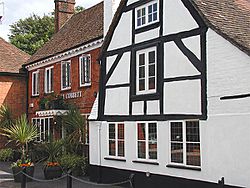
The important writer and politician William Cobbett was born in Farnham in 1763, in a pub called the Jolly Farmer. The pub is still there and is now called The William Cobbett.
The London and South Western Railway arrived in 1848. In 1854, nearby Aldershot became the "Home of the British Army." Both events greatly changed Farnham. The fast train link to London meant that business people could live in Farnham and still work in the city. Farnham became one of the first "commuter towns." Also, soldiers would arrive by train at Farnham station and then march to Aldershot until 1870. Many officers and their families chose to stay in Farnham.
In 1895, the Farnham Urban District Council (FUDC) was formed. In 1930, the council bought Farnham Park. That same year, St Joan of Arc Church was built. The FUDC was replaced in 1973, and Farnham became part of the new Waverley District Council. In 1984, Farnham Parish Council became Farnham Town Council.
Farnham Maltings, a community arts centre, was once a tannery and then part of the Farnham United Breweries. When brewing stopped, local people raised money to buy the building and turn it into a community centre.
Getting Around Farnham
Trains
Farnham railway station has train services run by South Western Railway. You can catch trains between Alton and London Waterloo. There are also services to Guildford.
Roads
The A31 Farnham bypass connects the town to Winchester, Alton, and Guildford. The A325 links Farnham to Farnborough and the A3 (London-Portsmouth). The A287 connects Farnham to the M3 at Hook and the A3 at Hindhead.
Buses
Several bus routes serve Farnham, mostly run by Stagecoach from Aldershot bus station. The Waverley Hoppa offers on-demand transport for travel between Farnham and nearby villages.
Airports
For business travellers, the nearest airport is Farnborough Airport. The closest major airport is London Heathrow Airport, about 31 miles away by road. Gatwick Airport and Southampton Airport are both about 43 miles away.
Walking and Cycling Routes
Farnham is the starting point of the North Downs Way, a long-distance walking path. The Pilgrims Way, an old route from Winchester to Canterbury, also passes through. The St. Swithun's Way offers a pleasant walking route to Winchester.
The southern part of Farnham, Rowledge, is next to the South Downs National Park. National Cycle Route 22 goes through Farnham, linking it to Guildford, the Isle of Wight, and the New Forest.
Farnham's Economy and Shops
Farnham is a busy market town with many shops along its main streets: West Street, The Borough, and East Street. The town has many independent shops, some of which have been open since the 1800s, like Rangers Furnishing Stores (since 1895) and Elphicks department store (since 1881). Pullingers (since 1850) is thought to be Farnham's oldest business, now a chain of art shops. You'll also find many national chain stores and grocery markets.
Castle Street used to have market stalls, but now it has semi-permanent buildings. Once a month, a farmers' market is held in the central car park, selling fresh produce from local farms. The Farnham Maltings hosts a monthly market for arts, crafts, antiques, and bric-a-brac, along with special fairs.
Public Services and Fun Things to Do
Farnham Library
Farnham Library moved to its current spot in Vernon House in 1990. It was updated in 2005 and is run by Surrey County Council. The library is in the historic Vernon House, where King Charles I slept on his way to his trial in London in 1649. A plaque on the wall marks this event. The library has public gardens with sculptures by local artists and students from the UCA.
Museum of Farnham
The Museum of Farnham is located in Willmer House, an 18th-century town house with beautiful brickwork. It has a collection of objects from different periods of the town's history, including ancient times.
The museum opened in 1961 to show the history of the local area. It's in a lovely old Georgian house with a walled garden. The displays include everything from archaeological finds to important artworks by local artists and a large collection of historical costumes. The museum also has a Local Studies Library for research.
Parks and Recreation
Farnham has two main parks in the town centre: Farnham Park and Gostrey Meadow. Farnham Park is right next to Farnham Castle. Gostrey Meadow is in the heart of Farnham, by the River Wey, and has a fenced play area for children. There's also a skate park and a leisure centre near the town centre.
Hospital and Cemeteries
Farnham Hospital is just northeast of town. It used to be the main hospital with emergency services, but now Frimley Park Hospital handles those. Farnham has four cemeteries managed by the Farnham Town Council: Hale Cemetery, Badshot Lea Cemetery, Green Lane Cemetery, and the West Street Cemetery.
Visiting Farnham: Tourism
Farnham has many attractive old houses and hidden passages that lead to old workshops, historic cottages, and secret gardens. Farnham Castle was built by the Normans and later became the Palace of the Bishops of Winchester. The former Bishops' Palace is now a training and conference centre. The castle's keep (the main tower) is open to the public, and guided tours of the palace are available weekly.
You can visit many places mentioned in the books of George Sturt. Waverley Abbey, the first Cistercian Abbey in England, is also open to the public. Farnham is on the edge of the Surrey Hills National Landscape, and the North Downs Way long-distance path starts here. Nearby attractions include Alice Holt Forest, Frensham Ponds, and beautiful heaths and downland scenery. The Rural Life Living Museum is close by in Tilford. Farnham is also a good base for visiting Winchester, the Mid-Hants Railway, and enjoying canal trips on the Basingstoke Canal and Wey Navigation.
Farnham's Culture and Arts
Farnham has a strong connection to the creative arts. Farnham School of Art opened in 1866 and was linked to the Arts and Crafts movement. Famous architects like Edwin Lutyens, painters like George Watts and W. H. Allen, and potters like Mary Watts worked in the area.
Farnham has several art galleries. The New Ashgate Gallery in Lower Church Lane shows work by both new and established artists. The gallery at Farnham Maltings also has frequent exhibitions.
Entertainment and Events
Farnham Maltings hosts many events, including opera, folk, and acoustic music gigs, band nights, and stand up comedy shows. They also have shows and workshops for young people. A cinema runs every Wednesday at the Maltings. There's a regular "Acoustic Fridays" night and a blues night in the "Cellar Bar." The Maltings also holds the annual Farnham Beer Exhibition, known as “Farnham Beerex,” celebrating the town's history with hops and beer. Many pubs in Farnham offer live music.
Farnham has an annual carnival, usually on the last Saturday in June. It's organized by the Farnham Lions Club and The Hedgehogs. Castle Street is closed for the evening, with bands, a beer tent, barbecue, and side shows. A parade of carnival floats, marching bands, and classic vehicles goes through the main streets. Local schools also join the parade, which has a different theme each year.
The Arts Scene
William Herbert Allen, a well-known English watercolour artist, lived and worked in Farnham for most of his life. He was the Master of Farnham Art School from 1889 to 1927, and many of his paintings show landscapes of the Farnham area. Illustrator Pauline Baynes spent much of her childhood in Farnham and studied at the Farnham School of Art. Fantasy artist Josephine Wall was also born and educated in the town.
Since Roman times, the local clay has been used for pottery and brickmaking. Pottery continued commercially until Farnham Pottery at Wrecclesham closed in 1998. Farnham Pottery became famous for its decorative items, especially "Farnham Greenware," during the Arts and Crafts movement. There was a strong link between the pottery and Farnham School of Art (now part of the University for the Creative Arts).
The Castle Theatre was replaced by the Redgrave Theatre in 1974, which closed in 1998. However, 'The New Farnham Repertory Company' (now Farnham Rep) was formed to continue repertory theatre in the town.
The Maltings: A Creative Hub
Productions still happen regularly at the Maltings, which also hosts touring shows. Sometimes, performances are held in the grounds of Farnham Library. The Maltings supports various types of music and has a dance studio. It's a creative arts centre for all ages, offering workshops, clubs, and groups for craft, theatre, music, and writing, including Rock Choir.
The New Ashgate Gallery
The New Ashgate Gallery is a non-profit charity in Farnham that focuses on contemporary art and craft. It holds exhibitions and projects with artists and makers. Started in 1959, it's the oldest craft space in the South of England and was the first gallery outside London to show both local and international artists. The gallery helps new artists by organizing competitions and support programs.
Peter Pan's Inspiration
It was in Farnham, while living at Black Lake Cottage near Tilford, that J. M. Barrie found the inspiration to write Peter Pan.
Bourne Wood The nearby Bourne Wood is a popular place for filming movies. It has appeared in films like Gladiator, Thor: The Dark World, and Wonder Woman.
Education in Farnham
Farnham has a mix of state, religious, and private schools. There are eight infant schools, nine primary/junior schools, three secondary schools, and two schools for students with special educational needs. There are also four independent schools in the Farnham area.
Farnham College (part of Guildford College) offers further education. The University for the Creative Arts (UCA) provides higher education. Some of Farnham's state schools, like South Farnham School and Weydon School, are known for their high academic results. South Farnham School has even been rated the best state primary school in the country based on exam results.
Farnham Grammar School was established before 1585. In 1973, its campus became a Sixth Form College and was renamed Farnham College.
Sports and Activities
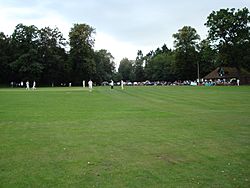
Farnham has various sports facilities, including a local leisure centre run by DC Leisure. The centre was built in 1981 with a swimming pool, gym, and main hall for team sports. It was updated in 2010, and the swimming pool was made exactly 25 metres long for competitions.
Farnham has two football clubs: Farnham Town F.C., which plays in a high league, and Farnham United FC, which has youth teams and one adult team.
Farnham Swimming Club (FSC) started in 1893 and is based at the leisure centre. It competes in national, regional, and county championships. Farnham Cricket Club was founded in 1782. Its current ground is near Farnham Park and the castle's old moat.
Farnham RUFC (Rugby Union Football Club) is located on Wilkinson Way. The Farnham Archers have a ground in Elstead. The Farnham and Aldershot hockey club has several men's and women's teams. Floorball hockey is also played by the Southern Vipers FBC adult team.
Farnham has a public golf course next to the cricket ground, behind Farnham Castle. It's a nine-hole, par-three course designed by Sir Henry Cotton.
The racing team Carlin Motorsport is based in Farnham.
Farnham's Population and Homes
In 1901, Farnham's population was about 14,000. Since the end of World War II, the population has grown to 39,488. About 16,500 people live in the town centre, while others live in the surrounding suburbs and villages.
In 2011, there were 16,050 households in Farnham. About 37.0% of homes were owned outright, and 37.6% were owned with a loan. This is similar to the regional averages for home ownership.
How Farnham is Governed
Farnham has elected representatives at the county, district, and town levels. At Surrey County Council, Farnham is represented by three councillors from three different areas. As of 2021, all three are members of the Farnham Residents party.
Farnham is the largest town in Waverley and has nine wards. It is represented by eighteen councillors at Waverley Borough Council. As of 2019, most councillors are from the Farnham Residents party, with some from the Liberal Democrats and Conservatives.
Local News
The Farnham Herald is the only newspaper specifically for Farnham. It was started in 1892. Farnham is also covered by the Ash & Farnham News & Mail.
Parks and Green Spaces
Gostrey Meadow
Until the late 1600s, Gostrey Meadow was part of the Bush Hotel's land. Over time, parts were sold off. By 1900, the meadow was being used as an illegal rubbish dump. In 1909, the Urban District Council bought the 4-acre site and turned it into a public park. They landscaped the area, and a drinking fountain was installed in 1911. The war memorial at the east end of the meadow was dedicated in April 1921.
Farnham Park
Farnham Park was created for Bishop William of Wykeham in 1376. It was first called the New or Little Park and was used as a deer park for Farnham Castle. By 1690, the larger Old Park was farmland, but the Little Park remained a deer park until the late 1700s. In the early 1800s, Bishop Brownlow North landscaped the park, adding walkways and new trees. In 1928, 295 acres were offered for sale to the town, and the purchase was completed in 1929.
Tice's Meadow, Badshot Lea
The 55-hectare (136-acre) Tice's Meadow in Badshot Lea was once a quarry. Sand and gravel mining ended in 2010, and the site was turned into a community nature reserve. It officially opened in May 2018. Tice's Meadow was bought by Surrey County Council in 2021. The reserve has open water, gravel islands, and woodlands. It's a home for many bird species, including reed warblers and sand martins. It has been named a Site of Nature Conservation Interest. In November 2022, the Tice's Meadow Bird Group won an award for their work in recording bird species at the site.
Famous People from Farnham
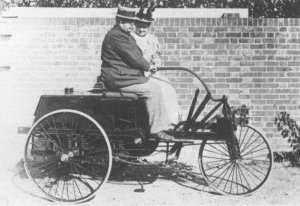
Here are some notable people who were born in or lived in Farnham:
- William Willett (1856), who campaigned for daylight saving time.
- George Sturt (1863), a writer and social historian.
- Maud Gonne (1866), a feminist and activist in Irish politics.
- John West (1778–1845), a famous missionary to Canada.
- John Abraham Nuske (1796–1865), a composer and guitarist, who owned a music shop on West Street.
- Richard Tice (1964), a businessman and politician.
Notable Farnham residents include:
- John Verney (author), a war hero, artist, and conservationist, lived at Runwick House from 1944 to 1976.
- Anthony Faramus, an actor, author, and concentration camp survivor.
- John Henry Knight (1847–1917), who built the first British motor car. He grew up in Weybourne.
- Reverend John Macleod Campbell Crum, who wrote the hymn Now the Green Blade Riseth, was Rector of Farnham from 1913 to 1928.
- Actor Jim Sturgess (1981-) was raised in Farnham.
- Christopher Steele, a British intelligence officer, lives in Farnham.
- Edgar Mittelholzer, a Guyanese author, lived in Farnham after moving to England.
Actors and Actresses
- Gerald Flood, a stage, TV, and film actor, lived in Farnham for most of his life.
- Peter Lupino, a well-known West End actor from the 1930s and 40s, also lived in Farnham.
- Actor Bill Maynard, known from Carry On and Heartbeat, was born in the town.
- The actor Bill Wallis lived in Farnham and started his acting career at the Castle Theatre.
- Opera singer Sir Peter Pears (1910–1986) was born in Farnham.
- Jessie Matthews (1907–1981), a famous actress, dancer, and singer, lived in Weybourne.
Sports Stars
- Cricketer "Silver Billy" Beldham (1766–1862) was born near Wrecclesham. He played in Farnham Cricket Club's first match.
- Graham Thorpe (1969–2024), an England cricket captain, was born in Farnham and played at the local cricket ground.
- Mike Hawthorn (1929–1959), who became the first British Formula One World Champion in 1958. His family moved to Farnham when he was two.
- Jonny Wilkinson (1979-), England's world-cup-winning rugby kicker and former captain, grew up in Farnham. He played for Farnham Rugby Football Club at a young age.
- Joel Freeland (born 1987), an international basketball player and NBA player, worked in Farnham.
- Tom Pollitt (1900–1979), a first-class cricketer.
- Gilbert White (1912–1977), a first-class cricketer.
- Fran Wilson (born 1991), an England Women's Cricket Player, was born in Farnham.
- Lottie Woad (born 2004), an amateur golfer.
See also
 In Spanish: Farnham para niños
In Spanish: Farnham para niños


